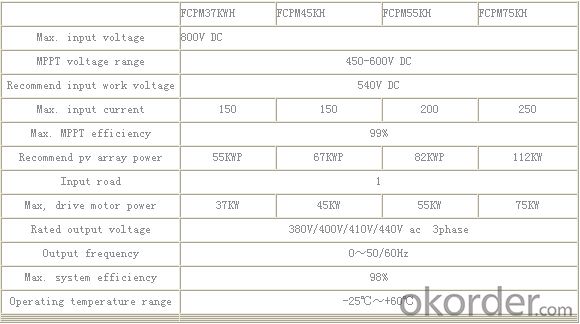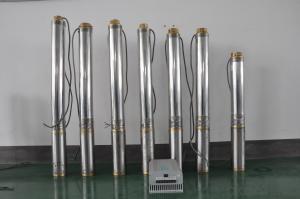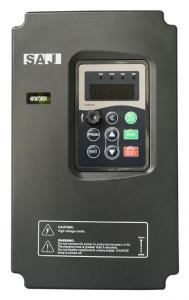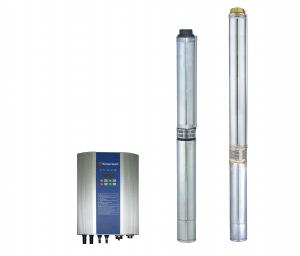Solar pump inverter FCPM75KH
- Loading Port:
- China Main Port
- Payment Terms:
- TT OR LC
- Min Order Qty:
- -
- Supply Capability:
- -
OKorder Service Pledge
Quality Product, Order Online Tracking, Timely Delivery
OKorder Financial Service
Credit Rating, Credit Services, Credit Purchasing
You Might Also Like
Solar pump inverter FCPM75KH Product Description:
Solar water pumping system is constructed with solar panel array,solar pump inverter and AC water pump, DC current produced from solar panel will be delivered to solar pump inverter,and it will convert it into AC current to drive water pump,and will automatically regulate output frequency according to sun radiance intensity,maximally realize MPPT tracking function.
Features
Adopting the proposed dynamic VI maximum power point tracking (MPPT) control method, with fast response, and reliable operation, achieves efficiency of 99%.
Designed with variable frequency driver, greatly improves efficiency
Extremely high efficiency
Digital mode control, with automatic operation and manual operation mode options
Complete protection functions
Adopts intelligent IPM module, with high reliability
LCD display and operation panel, in real time presents operating data
Optional for water level measurement and control circuit
Applicable for general ACC pumps, like centrifugal pump, piston pump etc.
Independent intellectual property; Highly effective, the redundant reliability, exempts the maintenance and the long life.
The pumps are soft started, fully protected.
No batteries are used. So better Sunlight, more water.
Datasheet.

- Q:Can a solar pump be used for water supply in off-grid botanical gardens?
- Yes, a solar pump can be used for water supply in off-grid botanical gardens. Solar pumps are particularly suitable for off-grid applications as they use solar energy to power the pump and do not require access to electricity. This makes them an environmentally friendly and cost-effective solution for water supply in remote locations such as botanical gardens.
- Q:How does a solar pump handle water with high levels of bacteria?
- A solar pump does not specifically handle water with high levels of bacteria. Its main function is to pump water from a source, such as a well or a reservoir, using solar energy as the power source. However, if water with high levels of bacteria is being pumped, it is essential to use additional water treatment methods, such as filtration or disinfection, to ensure the water is safe for use.
- Q:Can a solar pump be used in areas with limited access to water conservation?
- Yes, a solar pump can be used in areas with limited access to water conservation. Solar pumps are an efficient and sustainable solution for water pumping, especially in areas where traditional electricity supply is unreliable or unavailable. With the use of solar panels, these pumps can operate independently and draw water from various sources such as wells, rivers, or boreholes. This helps conserve water resources by utilizing renewable energy and reducing dependence on conventional power sources.
- Q:Can a solar pump be remotely monitored or controlled?
- Yes, a solar pump can be remotely monitored and controlled. With the advancement in technology, many solar pumps are now equipped with remote monitoring and control systems. These systems typically use wireless communication technologies such as GSM, GPRS, or satellite communication to enable remote access to the pump's performance data and control functions. Remote monitoring allows users to track the pump's operation, performance, and energy production in real-time from a central location. This information includes data such as water flow rates, power output, system efficiency, and battery charge levels. It helps in identifying any issues or inefficiencies promptly, allowing for timely maintenance or adjustments to optimize the pump's performance. Furthermore, remote control capabilities enable users to remotely operate and control the pump's functionality. This can include starting or stopping the pump, adjusting the speed or flow rate, changing the operational mode, or even toggling on/off the pump's power supply. These control features provide convenience and flexibility, especially in situations where physical access to the pump may be challenging or time-consuming. Overall, remote monitoring and control of solar pumps offer significant benefits in terms of efficiency, convenience, and cost savings. It allows for proactive maintenance, efficient energy management, and the ability to respond promptly to any issues or changes in operating conditions.
- Q:Are there any limitations on the water pressure that a solar pump can provide?
- Yes, there are limitations on the water pressure that a solar pump can provide. The maximum water pressure is determined by various factors such as the size and power of the pump, the height the water needs to be lifted, and the amount of sunlight available to power the pump. Generally, solar pumps may not be able to provide as high water pressure as electric or diesel pumps, but they can still meet the needs of many applications such as irrigation, livestock watering, and household use.
- Q:Can a solar pump be used in urban areas?
- Yes, a solar pump can be used in urban areas. Solar pumps are environmentally friendly and can provide a sustainable solution for water pumping in urban settings. They can be used for various applications such as supplying water to residential buildings, irrigation systems, and public parks. Solar pumps are cost-effective, require minimal maintenance, and can operate independently from the power grid, making them suitable for urban areas with limited access to electricity.
- Q:Can a solar pump be used for water supply in zoos and wildlife sanctuaries?
- Yes, a solar pump can definitely be used for water supply in zoos and wildlife sanctuaries. Solar pumps are an environmentally friendly option that can provide a sustainable and reliable source of water for animals. They can be powered by solar energy, eliminating the need for electricity or fuel, making them cost-effective and efficient in remote locations. Additionally, solar pumps can operate quietly, minimizing disturbances to the animals.
- Q:How does the size of the water distribution network affect the performance of a solar pump?
- The size of the water distribution network can impact the performance of a solar pump in several ways. Firstly, a larger network may require the pump to work harder in order to pump water across longer distances or to higher elevations, resulting in increased energy consumption and potentially decreased efficiency. Additionally, a larger network may require more frequent maintenance and repairs, as there are more pipes, valves, and connections that can become damaged or clogged. Furthermore, a larger network may also experience greater pressure variations, which can affect the pump's performance and require additional adjustments and monitoring. Overall, the size of the water distribution network can significantly influence the efficiency, reliability, and overall performance of a solar pump.
- Q:How does the size of a solar panel affect the performance of a solar pump?
- The size of a solar panel directly affects the performance of a solar pump. A larger solar panel can generate more electricity, which in turn provides more power to the pump, resulting in increased performance. A smaller solar panel, on the other hand, generates less electricity, limiting the power output and potentially reducing the performance of the solar pump.
- Q:Are there any specific requirements for the solar panel installation of a solar pump?
- Yes, there are specific requirements for the solar panel installation of a solar pump. Here are some key considerations: 1. Solar panel capacity: The solar panel system should have sufficient capacity to generate the necessary energy to power the solar pump. This depends on factors such as the pump's power requirements, daily water demand, and location's solar irradiation levels. It is crucial to accurately calculate the required capacity to ensure optimal performance. 2. Orientation and tilt: The solar panels should be installed in a location that receives maximum sunlight exposure throughout the day. The ideal orientation is facing south (in the Northern Hemisphere) or north (in the Southern Hemisphere) to capture the most sunlight. Additionally, the tilt angle of the solar panels should be set to optimize energy production based on the geographical latitude. 3. Shading: It is essential to avoid any shading on the solar panels, as even partial shading can significantly reduce their efficiency. Prior to installation, a thorough assessment of the surrounding environment should be conducted to identify potential shading sources, such as trees, buildings, or other structures. The solar panels should be positioned in an area with minimal shading. 4. Mounting structure: The solar panels must be securely mounted to withstand environmental conditions like wind, snow, and potential natural disasters. Depending on the installation location, the appropriate mounting structure should be selected, such as roof-mounted, ground-mounted, or pole-mounted systems. The structure should ensure proper ventilation and maintenance access for the solar panels. 5. Wiring and electrical connections: The wiring for the solar panels should be correctly sized to handle the electrical load and minimize energy losses. It is crucial to follow local electrical codes and safety guidelines during the installation process. Proper grounding and connection to the solar pump system are also important to ensure safe and efficient operation. 6. Maintenance and monitoring: Regular maintenance of the solar panels is necessary to ensure optimal performance and longevity. This includes cleaning the panels from dust, dirt, or debris and inspecting for any damage. Additionally, monitoring systems can be installed to track the energy generation and diagnose any potential issues promptly. It is important to consult with a qualified solar installer or engineer to determine the specific requirements for the solar panel installation of a solar pump, as they can provide expertise tailored to your specific needs and location.
1. Manufacturer Overview |
|
|---|---|
| Location | |
| Year Established | |
| Annual Output Value | |
| Main Markets | |
| Company Certifications | |
2. Manufacturer Certificates |
|
|---|---|
| a) Certification Name | |
| Range | |
| Reference | |
| Validity Period | |
3. Manufacturer Capability |
|
|---|---|
| a)Trade Capacity | |
| Nearest Port | |
| Export Percentage | |
| No.of Employees in Trade Department | |
| Language Spoken: | |
| b)Factory Information | |
| Factory Size: | |
| No. of Production Lines | |
| Contract Manufacturing | |
| Product Price Range | |
Send your message to us
Solar pump inverter FCPM75KH
- Loading Port:
- China Main Port
- Payment Terms:
- TT OR LC
- Min Order Qty:
- -
- Supply Capability:
- -
OKorder Service Pledge
Quality Product, Order Online Tracking, Timely Delivery
OKorder Financial Service
Credit Rating, Credit Services, Credit Purchasing
Similar products
New products
Hot products
Hot Searches
Related keywords




























